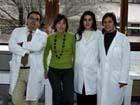Vitamin A to remove leukemia cells
2006/01/01 Andonegi Beristain, Garazi - Elhuyar Zientziaren Komunikazioa Iturria: Elhuyar aldizkaria
Vitamin A is also known as retinol. They contain milk, liver, egg yolks, butters, etc. and, as carotenes, also yellow-orange vegetables like carrot and pumpkin.

Retinoids participate in three processes: death, separation and cell reproduction. In the department of Cell Biology and Histology of the UPV/EHU about 10 years ago, research began on how cell death was strengthened through retinoids. They wanted to use this ability to kill certain cells, including cancer cells.
Programmed death
Two types of deaths occur in cells: necrosis and apoptosis. Necrosis is the word to define pathological death, that is, when the diseased cell. The cell may die from food or lack of oxygen, in which case it is necrosis.
On the contrary, apoptosis is a programmed, clean and necessary death. Some cells must die so that our body continues to function well, for example, when in the mother's womb the hands of the fetus form, at first between the fingers there is a membrane. Precisely, the cells of this membrane must die so that the hands develop well. The death of these cells is programmed in the genes of the fetus and has a certain function. That is apoptosis.
All cells have information to make apoptosis, but of course not all should die. This mechanism is initiated by both internal and external signals or stimuli, only when necessary. There are several modulating substances, including retinoids.
Able to boost apoptosis
Among retinoids, UPV researchers chose retinamide for their research. Retinamide is a synthetic retinoid, that is, it is not a natural substance that produces our body.

In fact, in some types of leukemias, lymphoblastic leukemias, UPV has investigated the effect of retinamide. Samples from the Cruces Hospital are currently used to obtain the cells from these leukemias.
Lymphoblastic leukemias, as the name suggests, are lymphoblastic cancers. Lymphoblasts are large precursor cells of lymphocytes. These malignant lymphoblasts fragment continuously, build up in the bone marrow, and prevent the production of blood cells. Laboratory trials have shown that 95% of these lymphoblasts affected by retinamide are killed.
To explain this process, UPV researchers have studied the molecular mechanism. Retinamide apparently reinforces the internal oxidant stress of the cell, which activates the mechanisms that cause cell death. This death occurs programmatically and cleanly, and for this purpose a group of enzymes cuts the proteins found within the cell. So the cell dies. This death does not affect adjacent healthy cells, so no inflammation occurs and the side effects are minimal.

Customized treatment
Clarifying the molecular pathway, researchers have studied why retidamide does not affect healthy cells. Other factors have been found there. In fact, according to these factors, the influence of retinamide is stronger in malignant cells and healthy cells barely perceive it. Therefore, it is clearly seen that these factors, and perhaps others, should be taken into account before the publication of retinamide-based drugs.
In addition, according to the researchers, in the future the treatment adapted to each patient will be consolidated. It is known that, despite the same disease, treatments do not equally affect all people, which may depend on other factors mentioned above.
Therefore, the new medical guidelines increasingly insist on the need to perform an analysis of the genetic characteristics of each and other factors, as well as the subsequent fixation of treatment. In the case of retinamide treatment is also expected to consolidate, but for this it is necessary to know previously the influence of retinamide on cells and this research will contribute significantly to this path.




